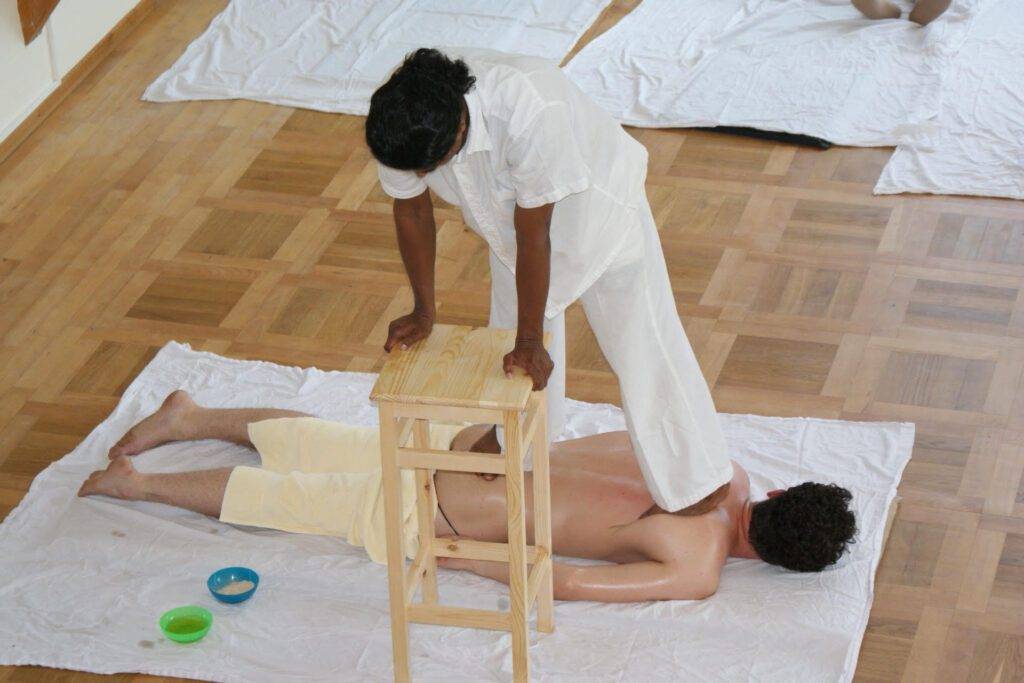If you have ever dreamt about extending your yoga practice or moving into a teaching position, you have probably also heard a variety of tales, ideas, and sometimes teachers’ flat-out myths. There are many yoga teacher training myths that can discourage newcomers. Although it may seem scary to newcomers, it is among those events that many describe as “life-changing.”
Will I be flexible enough? Is it quite spiritual? Must I give up my job after I graduate? Should I just wish to develop personally rather than instruct?
Most people don’t realize that yoga teacher training (YTT) is far more approachable—and more personal—than most people believe. Let’s clarify the ambiguity and examine what actually transpires when you choose to make that plunge.
Four of the most often held fallacies that prevent people from even beginning the path will be examined below.
Yoga Teacher Training Myth 1: You Need to Be Already Flexible or Super Fit

The most tenacious myth about yoga instructor training is that it’s only for the physically adept—that is, those capable of folding into a pretzel. float gracefully into handstand shapes or
Here is the truth, though: you do not have to be flexible or have a flawless physique to start teacher training. Curiosity, constancy, and an open mind are required.
Yoga is awareness rather than performance. Though it is never the target, practice can occasionally provide flexibility as a byproduct. Teacher training aims to enable you to investigate the why and how behind every posture rather than just the what. You will acquire knowledge of anatomy, alignment, and modification ideas so you can modify stances for any body type, including your own.
Many individuals really come into YTT with physical restrictions or damage. By means of instruction and direction, they acquire knowledge of how to move more wisely and ecologically. Ironically, because they actually know what it is to operate inside boundaries, the pupils who begin “least flexible” often become the most compassionate and accomplished instructors.
I used to believe yoga wasn’t for me since I couldn’t touch my toes, one graduate remarked. Yoga is now precisely what enabled me to cease worrying about that.
You can do yoga and start teacher training if you can breathe. The path is more about broadening your consciousness than it is about bodily flexibility.
Yoga Teacher Training Myth 2: Teacher Training Is Too Spiritual, Weird, or Intense for Beginners
If you are just getting acquainted with yoga ideology, phrases like chakra, mantra, or asana can sound mystical (or even scary). Some individuals are concerned that teacher training will force them into unknown spiritual ground or require them to embrace a belief system with which they disagree.
Here is the truth: Inclusive rather than dogmatic good teacher training programs exist. They neither demand that you believe anything blindly. They instead encourage you to investigate old teachings and determine what resonates for you.
Yes, contemporary training seeks to make the principles of yoga usable; it is part of what makes it so rich and transformational. It draws from spiritual philosophy. Not because you are expected to become a monk, but rather because these instruments enable you to live and teach with greater presence, you might investigate ideas like self-inquiry, compassion, or mindfulness.
Think of it this way: the spiritual side of yoga is about learning how to face reality gracefully, not about avoiding it.
Know that courses are arranged sequentially if intensity causes you concern. Early meetings usually cover rudimentary philosophy, anatomy, and fundamental positions. Gradually, you’ll investigate more complex levels like sequencing, adaptation, and teaching practice as your confidence rises.
About chanting “Om” or meditating for the first time, it’s quite natural to be anxious. Everywhere starts somewhere; instructors get that. A competent facilitator will always leave room for skepticism, inquiries, and individual interpretation.
Thus, if you are willing to study but not seeking to join a cult, teacher training will probably provide a revitalizing blend of science, self-study, and spirituality. Being “spiritual enough” is not the point here. It’s about finding your idea of connection and equilibrium.
Yoga Teacher Training Myth 3: Once You Finish, You’ll Teach Full Time — Reality Check + Possible Paths
Many people think that getting your 200-hour certification automatically puts you into full-time teaching. Some graduates do pick that path, yet many others apply their knowledge in more part-time or personal capacities.
The truth is that you get to select which doors to walk through; teacher education opens possibilities.
Some people find teaching to be a fresh job. They could first take one or two courses a week, get experience, and then move into full-time teaching, studio management, or even own their own space.
For others, yoga is still a side project—a way to intensify personal practice, direct community classes, or just fit mindfulness into everyday life or another job. Frequently turning to YTT to improve their communication, emotional regulation, and leadership abilities are nurses, therapists, teachers, corporate executives, and parents.
While it is definitely possible to teach yoga full-time, it is a process. Like any profession, creating trust, networks, and consistency takes time. Most instructors start slowly, combining yoga with other tasks to discover their genuine teaching voice.
Regarding your training as an evolution rather than a career shift. It links you to a supportive community, broadens your skill set, and helps you clearly express your values.
Several potential post-training routes are provided here:
Leading classes a few times per week at neighborhood studios, gyms, or companies, the Community Instructor
- The Specialist: Including yoga into particular domains, including physical therapy, counseling, education, or sports coaching.
- The Entrepreneur: Based on uncommon interests, creating online content, seminars, or retreats.
- The Lifetime Student: Using the training just for self-growth, never needing to educate.
- Every one of these ways has merit. Certification gives you a choice instead of locking you into one conclusion.
Therefore, if the concept of teaching full-time is overwhelming, unwind. Before you start, you don’t need to have everything sorted out. Your training is the beginning, not the finishing point.
Yoga Teacher Training Myth 4: Certification Only — No Real Transformation
Some doubters view yoga teacher training as merely another credential to hang on the wall—a transactional event instead of a transformative one.
And yes, technically, you do receive a certification acknowledged by Yoga Alliance or a comparable group. But inquire of virtually any graduate, and they will say: the real benefit is not the piece of paper.
Day by day, as you study, move, and reflect, the true change occurs softly. You begin to see patterns: how you respond under duress, how you speak to yourself, how you approach rest and effort. Teacher training reveals your behavior and encourages you to purposefully re-pattern it.
Yoga instruction is all-consuming, unlike a standard fitness certification. You devote months (or weeks) learning not just anatomy and positions but also philosophy, communication, and emotional intelligence. You develop the ability to lead others with compassion and to see yourself free of prejudice.
This kind of internal effort calls for honesty and vulnerability; thus, it can be unpleasant at times. But it’s also incredibly freeing. Graduates frequently say they are more confident, grounded, and related to their purpose—not because someone instructed them what to believe but rather because they saw it personally.
Here are a few instances of how change might develop:
- A reserved attendee finds clarity of voice leading a little group.
- A perfectionist discovers that “doing less” usually provides more balance.
- Through presence and breathwork, a lifelong over-thinker finds peace.
- These are actual changes that affect relationships, jobs, and daily life; they are not abstract ideas.
So, yes, you will receive a certificate. You will more critically grow self-awareness, emotional resilience, and a closer sense of connection—attributes that go well beyond the yoga mat.
Final Thoughts: The Truth About YTT
Yoga training is not about becoming someone else. It’s about finding more of who you currently are.
The legends usually arise from anxiety or ignorance:
“I lack flexibility.”
“It’s very spiritual.”
“I have to resign and instruct.”
“It’s just a certificate.”
But YTT is really a guided trip of self-inquiry, community, and personal growth. It welcomes you where you are and encourages you to grow—physically, intellectually, emotionally, and possibly spiritually.
Whether you want to lead courses, spread awareness in your neighborhood, or just educate yourself more about your body and mind, teacher training provides lifelong instruments.
Therefore, should you have been doubting whether you are ready, think on this little nudge: you don’t have to be ideal, spiritual, or career-ready. You only have to be ready.
With training, patience, and presence, the rest develops naturally.






